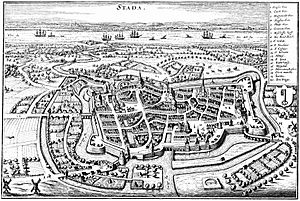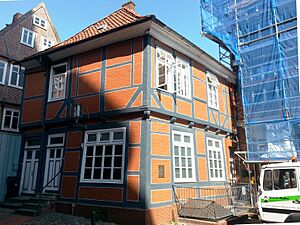Stade facts for kids
Quick facts for kids
Stade
Hansestadt Stade
Hansestadt Stood |
||
|---|---|---|

View of the historic harbour in Stade
|
||
|
||
| Country | Germany | |
| State | Lower Saxony | |
| District | Stade | |
| Elevation | 9 m (30 ft) | |
| Population
(2022-12-31)
|
||
| • Total | 48,353 | |
| Time zone | CET/CEST (UTC+1/+2) | |
| Postal codes |
21680, 21682–21684
|
|
| Dialling codes | 04141, 04146 | |
| Vehicle registration | STD | |
| Website | www.stade.de | |
Stade is a historic city in northern Germany, located in the state of Lower Saxony. It is officially known as the Hanseatic City of Stade. The city was first mentioned in records way back in 934. Today, it is the main town of the Stade district.
Stade is about 45 kilometers (28 miles) west of Hamburg. It is part of the larger Hamburg area. The city sits near the lower part of the Elbe river. It is also a stop on the famous German Timber-Frame Road, which features many beautiful old buildings.
Contents
A Look Back at Stade's Past
People first settled in the Stade area around 30,000 BC. This shows how ancient the region is!
Viking Raids and Early Rulers
In the 990s, Swedish and Danish Vikings attacked Stade. They were led by Eric the Victorious. The Vikings looted the town and took many valuable things.
After these raids, Stade became part of the Prince-Archbishopric of Bremen in 1180. This meant it was ruled by a powerful religious leader. In the early 1200s, King Valdemar II of Denmark and his troops took over Stade. However, the city was often fought over.
On May 2, 1209, Emperor Otto IV gave Stade important "town privileges." These were special rights that made the citizens free and allowed them to govern themselves more. They could own property and had fair legal processes.
The Hanseatic League and Swedish Rule
For many centuries, from the 1200s to the late 1600s, Stade was an important member of the Hanseatic League. This was a powerful group of trading cities in northern Europe. Stade was a busy port, but later, Hamburg grew even bigger.
In 1648, after a long war called the Thirty Years' War, Stade became part of the Duchy of Bremen. This duchy was given to the Swedish crown. So, Stade was under Swedish rule from 1645 to 1712. You can still see some buildings from this Swedish time today.
A big fire in 1659 destroyed two-thirds of the town. But Stade was rebuilt following the same plan.
Danish and Hanoverian Times
In 1712, Denmark-Norway took over Stade. Danish troops attacked the town, destroying many houses. Stade remained the capital of the Bremen-Verden region even after Denmark gave it to the Electorate of Hanover in 1715.
In 1823, Stade continued to be the capital of its region. Sadly, the city suffered from the plague in 1355 and 1712. These outbreaks killed a large part of the city's population.
In 1849, Stade's synagogue, a place of worship for the Jewish community, opened. However, it closed in 1908 due to money problems. Many Jewish people from the Stade region were later deported during World War II. Luckily, Stade itself was not bombed during the war.
Modern Stade and Industry
In recent decades, Stade has grown thanks to industries like chemicals and aerospace. Big companies like Dow Chemical and Airbus have facilities here.
Stade also had a Stade Nuclear Power Plant near the Elbe river. It operated from 1972 to 2003. It was one of the first German nuclear plants to close down as Germany decided to stop using nuclear power.
Cool Places to See in Stade
Stade's Old Town has many interesting old buildings.
- The St. Cosmae et Damiani Lutheran Church and the Wilhadi Lutheran Church are beautiful churches.
- The historic city hall is also a must-see.
- You can also visit the Schwedenspeicher (Swedish warehouse) and the Zeughaus (Swedish armory). These buildings remind us of Stade's past under Swedish rule.
Near Stade, you can see the huge pylons of Elbe Crossing 1 and Elbe Crossing 2. The pylons for Elbe Crossing 2 are among the tallest in Europe!
Getting Around Stade
Since late 2007, Stade has been connected to the S-Bahn Hamburg train system. Line S3 trains leave Stade station often. They can get you to Hamburg central station in about an hour.
Local Businesses and Jobs
Stade is home to several important companies:
- Dow Chemical (chemicals)
- Airbus Deutschland GmbH (aerospace)
- E.ON (power plant)
- Air Liquide (industrial gases)
- Air Products & Chemicals (industrial gases)
- Aluminium Oxid Stade GmbH (makes aluminum oxide)
- Stähler Agrochemie (makes fertilizers)
- PROKON Nord Energiesysteme GmbH (makes wind turbines and biofuels)
- Lindemann (Bauunternehmen) (construction)
Stade's Sister Cities
Stade has special connections with other cities around the world:
 Giv'at Shmuel, Israel
Giv'at Shmuel, Israel Gołdap, Poland
Gołdap, Poland Karlshamn, Sweden
Karlshamn, Sweden
Famous People from Stade
Many interesting people have come from Stade:
- Stefan Aust (born 1946), a well-known journalist.
- Maria Aurora von Königsmarck (1662–1728), a countess and important figure in history.
- Angela Denoke (born 1961), a famous opera singer.
- Tabea Kemme (born 1991), a talented footballer who played for the German women's national team.
- Marnon Busch (born 1994), another footballer who has played many games.
Images for kids
See also
 In Spanish: Stade para niños
In Spanish: Stade para niños
- Horstsee

















